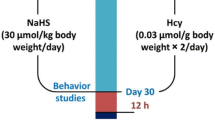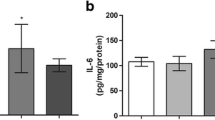Abstract
Homocysteine (Hcy), an independent risk factor for atherosclerosis, undergoes auto-oxidation and generates reactive oxygen species, which are thought to be main cause of Hcy neurotoxicity. However, the mechanisms leading to neurodegenerative disorders are poorly understood because studies that have investigated the potential neurotoxicity of hyperhomocysteinemia in vivo are scarce. The purpose of this study was to test whether daily administration of methionine, which induces hyperhomocysteinemia, causes glial hyperactivity, and also to investigate the protective effects of melatonin on the brain tissue against oxidative stress of Hcy in rats. There was a significant development of oxidative stress as indicated by an increase in malondialdehyde + 4-hydroxyalkenals in hippocampus and cortex of hyperhomocysteine mic rats, whereas significant reduction was found in the activity of glutathione peroxidase (GSH-Px). Co-treatment with melatonin inhibited the elevation of lipid peroxidation and significantly increased GSH-Px activity in the brain regions studied. Western blot analysis revealed an increase in glial fibrillary acidic protein (GFAP) contents both in hippocampus and frontal cortex (p < 0.001) of hyperhomocysteinemic rats compared to the controls. Administration of melatonin significantly decreased GFAP contents in hippocampus and cortex (p < 0.05). S100B contents increased only in frontal cortex in hyperhomocysteinemic rats compared to the control (p < 0.01) and was inhibited by melatonin treatment (p < 0.01). The present findings show that Hcy can sensitize glial cells, a mechanism which might contribute to the pathogenesis of neurodegenerative disorders, and further suggest that melatonin can be involved in protecting against the toxicity of Hcy by inhibiting free radical generation and stabilizing glial cell activity.
Similar content being viewed by others
Abbreviations
- GFAP:
-
glial fibrillary acidic protein
- GSH-Px:
-
glutathione peroxidase
- Hcy:
-
homocysteine
- LOP:
-
lipid peroxidation
- Mel:
-
melatonin
References
Finkelstein, J. D. (2000) Semin. Thromb. Hemost., 26, 219–225.
Ho, P. I., Ortiz, D., Rogers, E., and Shea, T. B. (2002) J. Neurosci. Res., 70, 694–702.
Hankey, G. J., and Eikelboom, J. W. (1999) Lancet, 354, 407–413.
Lipton, S. A., Kim, W. K., Choi, Y. B., Kumar, S., D’Emilia, D. M., Rayudu, P. V., Arnelle, D. R., and Stamler, J. S. (1997) Proc. Natl. Acad. Sci. USA, 94, 5923–5928.
Stamler, J. S., Osborne, J. A., Jaraki, O., Rabbani, L. E., Mullins, M., Singel, D., and Loscalzo, J. (1993) J. Clin. Invest., 91, 308–318.
Heinecke, J. W. (1988) in Oxyradicals in Molecular Biology and Pathology (Cerruti, P. A., Fridovich, I., and McCord, J. M., eds.) Alan R. Liss, New York, pp. 443–457.
Upchurch, G. R., Jr., Welch, G. N., Fabian, A. J., Freedman, J. E., Johnson, J. L., Keaney, J. F., Jr., and Loscalzo, J. (1997) J. Biol. Chem., 272, 17012–17017.
Maler, J. M., Seifert, W., Huther, G., Wiltfang, J., Ruther, E., Kornhuber, J., and Bleich, S. (2003) Neurosci. Lett., 347, 85–88.
Moonen, G., Rogister, B., Leprince, P., Rigo, J. M., Delree, P., Lefebvre, P. P., and Schoenen, J. (1990) Progr. Brain Res., 86, 63–73.
Reier, P. J., and Houle, J. D. (1988) Adv. Neurol., 47, 87–138.
O’Callaghan, J. P., Jensen, K. F., and Miller, D. B. (1995) Neurochem. Int., 26, 115–124.
Baydas, G., Nedzvetskii, V. S., Tuzcu, M., Yasar, A., and Kirichenko, S. V. (2003) Eur. J. Pharmacol., 462, 67–71.
Liedtke, W., Edekmann, W., Bieri, P. L., Chiu, F. C., Cowan, N. J., Kucherlapati, R., and Raine, C. S. (1996) Neuron, 17, 607–615.
Cerutti, S. M., and Chadi, G. (2000) Cell. Biol. Int., 24, 35–49.
Kligman, D., and Marshak, D. R. (1985) Proc. Natl. Acad. Sci. USA, 82, 7136–7139.
Persson, L., Hardemark, H. G., Gustafsson, J., Rundstrom, G., Mendel-Hartvig, I., Esscher, T., and Pahlman, S. (1987) Stroke, 18, 911–918.
Baydas, G., Reiter, R. J., Yasar, A., Tuzcu, M., Akdemir, I., and Nedzvetskii, V. S. (2003) Free Rad. Biol. Med., 35, 797–804.
Baydas, G., Tuzcu, M., Yasar, A., and Baydas, B. (2004) Acta Diabetol., 41, 123–128.
Tan, D. X., Chen, L. D., Poeggeler, B., Manchester, L. C., and Reiter, R. J. (1993) Endocrine J., 1, 57–60.
Zhang, H., Squadrito, G. L., and Pryor, W. A. (1998) Biochem. Biophys. Res. Commun., 251, 83–87.
Bagi, Z., Cseko, C., Toth, E., and Koller, A. (2003) Am. J. Physiol. Heart. Circ. Physiol., 285, 2277–2283.
Lawrence, R. A., and Burk, R. F. (1976) Biochem. Biophys. Res. Commun., 71, 952–958.
Baydas, G., Gursu, M. F., Cikim, G., and Canatan, H. (2002) J. Pineal Res., 32, 63–64.
Baydas, G., Yilmaz, O., Celik, S., Yasar, A., and Gursu, M. F. (2002) Arch. Med. Res., 33, 515–519.
Kim, J. P., Koh, J. Y., and Choi, D. W. (1987) Brain Res., 437, 103–110.
Reutens, S., and Sachdev, P. (2002) Int. J. Geriatr. Psychiatry, 17, 859–864.
Jara-Prado, A., Ortega-Vazquez, A., Martinez-Ruano, L., Rios, C., and Santamaria, A. (2003) Neurotox. Res., 5, 237–243.
Dayal, S., Arning, E., Bottiglieri, T., Boger, R. H., Sigmund, C. D., Faraci, F. M., and Lentz, S. R. (2004) Stroke, 35, 1957–1962.
Goth, L., and Vitai, M. (2003) Free Rad. Biol. Med., 35, 882–888.
Osuna, C., Reiter, R. J., Garcia, J. J., Karbownik, M., Tan, D. X., Calvo, J. R., and Manchester, L. C. (2002) Pharmacol. Toxicol., 90, 32–37.
Baydas, G., Kutlu, S., Naziroglu, M., Canpolat, S., Sandal, S., Ozcan, M., and Kelestimur, H. (2003) J. Pineal Res., 34, 36–39.
Yamamato, M., Hara, H., and Adachi, T. (2000) FEBS Lett., 486, 159–162.
Bates, K. A., Fonte, J., Robertson, T. A., Martins, R. N., and Harvey, A. R. (2002) Neuroscience, 113, 785–796.
Banati, R. B., Gehrmann, J., Schubert, P., and Kreutzberg, G. W. (1993) Glia, 7, 111–118.
Baydas, G., Reiter, R. J., Nedzvetskii, V. S., Yasar, A., Tuzcu, M., Ozveren, F., and Canatan, H. (2003) Toxicol. Lett., 137, 169–174.
Baydas, G., Reiter, R. J., Nedzvetskii, V. S., Nerush, P. A., and Kirichenko, S. V. (2002) J. Pineal Res., 33, 134–139.
Author information
Authors and Affiliations
Corresponding author
Additional information
Originally published in Biochemistry (Moscow) On-Line Papers in Press, as Manuscript BM05-001, June 12, 2005.
Rights and permissions
About this article
Cite this article
Baydas, G., Ozer, M., Yasar, A. et al. Melatonin prevents oxidative stress and inhibits reactive gliosis induced by hyperhomocysteinemia in rats. Biochemistry (Moscow) 71 (Suppl 1), S91–S95 (2006). https://doi.org/10.1134/S0006297906130153
Received:
Revised:
Issue Date:
DOI: https://doi.org/10.1134/S0006297906130153




